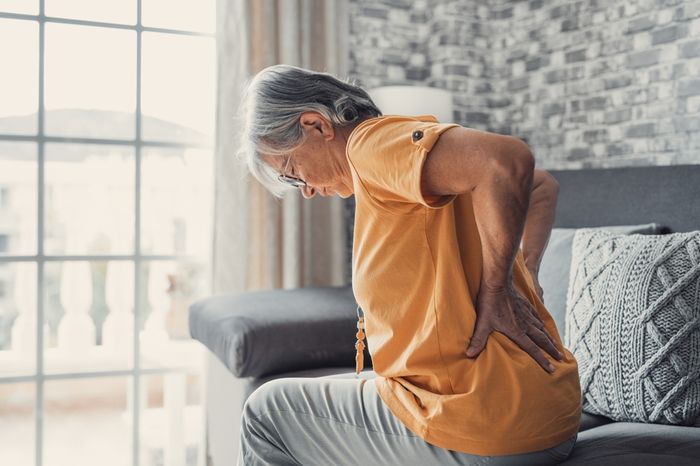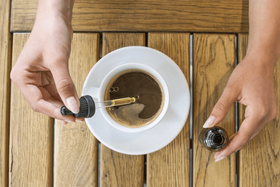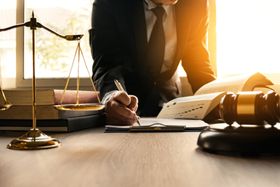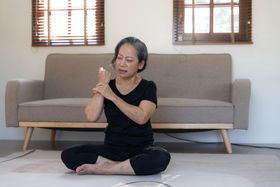The Menopause Back Pain Breakthrough: Causes and Treatments
Updated September 20, 2023.

Menopause signals the end of a woman’s reproductive years. The period is characterised by different symptoms, including hot flashes, joint pain, mood swings, night sweats, sleep disturbances, and vaginal dryness caused by dropping oestrogen and progesterone levels.
Back pain is a common complaint of women transitioning through menopause. While back pain is common among older adults, it is more severe in menopausal women.
Causes of Menopause Back Pain
Changes in Oestrogen Level
Oestrogen plays a critical role in maintaining bone density and strength. As the levels reduce during menopause, it leads to weakening bones and a higher risk of fracture (stress fracture and vertebral compression fracture), leading to back pain. Also, oestrogen regulates collagen production, which supports the body's joints.
» Discover the best natural ways to boost oestrogen
Weight Gain
Lower progesterone levels mean a reduced metabolic rate and a possible increase in appetite. Together with changes in body composition, this may lead to weight gain that increases pressure on the spine, muscle tension, and back pain. Also, excess weight may lead to herniated discs, spinal stenosis, and arthritis of the lumbar spine.
Degenerative Arthritis
Ageing is associated with wear and tear of the joints. In perimenopausal women, wear and tear in the vertebrae over time can also result in back pain.
Muscle Strain and Tension
Hormonal changes can increase muscle tension and tightness, which can increase pain in the back muscles.
Disease Conditions
Conditions like fibromyalgia and rheumatoid arthritis can cause severe back pain. With fibromyalgia, there is widespread discomfort, fatigue, and tenderness in the muscles and soft tissues of the back. With rheumatoid arthritis, inflammation in multiple joints, including the spine, causes extreme pain.
Poor Posture
Weakening muscles with age can contribute to poor posture, which leaves the back without proper support, causing strain and leading to lower back pain.
Muscle Imbalance
Back alignment is maintained by the co-action of the core back and abdominal muscles. When the abdominal muscles are stronger than the back muscles, tension builds and alters the body's alignment, leading to muscle strain and pain.
Treatment Options for Menopause Back Pain
While the treatment of menopausal back pain may vary depending on the underlying cause and severity, here are some common and effective treatment options:
Lifestyle and Dietary Adjustments
This includes the following:
- Regular exercise
- Keeping a healthy weight
- Good posture
- Eating a healthy and anti-inflammatory diet
- Ensuring proper support for the back
» Find joint pain relief with these menopause-friendly exercises
Over-The-Counter Medication
Medications like acetaminophen can help prevent inflammation and relieve mild to moderate back pain.
Physiotherapy
A physical therapy regimen can help improve back mobility and strengthen the back muscles. It can also address postural problems, aid muscle relaxation, and increase flexibility, all of which contribute to reducing back pain.
Hormonal Therapy
Hormonal replacement therapy can help restore oestrogen and progesterone levels and alleviate the problems contributing to the increased risk of back pain.
Relaxation Techniques
Proper rest or sleep can help alleviate pain related to stress and muscle tension. Yoga, meditation techniques, a walk in the park, deep breathing techniques, and journaling can also help.
» Learn more: Stress-relieving tips for adult women
Vitamins and Supplements
Perimenopausal women are at risk for Vitamin D and calcium deficiency, which may lead to muscle spasms and osteoporosis. Taking supplements may help prevent these deficiencies.
Alternative Therapies
Approaches like acupuncture, massage, and chiropractic care may also bring back pain relief, though you should always consult your medical care provider before trying out any alternative therapies.
Surgery
Surgery becomes an option when back pain does not respond to conservative treatment. Surgical approaches include spinal fusion, laminectomy, or discectomy.
Take Action Today
Although menopause may be inevitable, that's no reason to give up and let back pain and other symptoms worsen rapidly. There are many techniques you can follow to begin to alleviate your symptoms, most of which can be carried out in the comfort of your own home and without costly procedures or equipment.
» Not sure where to begin? Find your personalised wellness routine with our quiz










